The value of a 1923 penny is heavily influenced by its minting location. These coins were minted in two mints—Philadelphia and San Francisco. While the Philadelphia coins weren’t particularly rare compared to other Lincoln pennies, the San Francisco coins are incredibly scarce, making them more valuable today.
Whether you’ve inherited a 1923 penny from a family collection or found one in your spare change, consider yourself lucky. Regardless of the condition and mint mark, 1923 pennies are more valuable than their one-cent face value.
Here’s a 1923 Penny Value Chart to give you an idea of how much they’re worth:
| Mint Mark | Color | Extremely Fine | AU58 About Uncirculated | MS62 Uncirculated | MS64 Choice Uncirculated | MS65 Gem Uncirculated |
|---|---|---|---|---|---|---|
| 1923 No Mint Mark (P) Penny Value | MS Brown | $10 | $18 | $32 | $70 | $225 |
| MS Red Brown | – | $45 | $100 | $225 | ||
| MS Red | $60 | $130 | $350 | |||
| 1923 “S” Penny Value | MS Brown | $45 | $240 | $450 | $850 | $3,750 |
| MS Red Brown | – | $475 | $2,000 | $6,000 | ||
| MS Red | $1,000 | $7,000 | $60,000 |
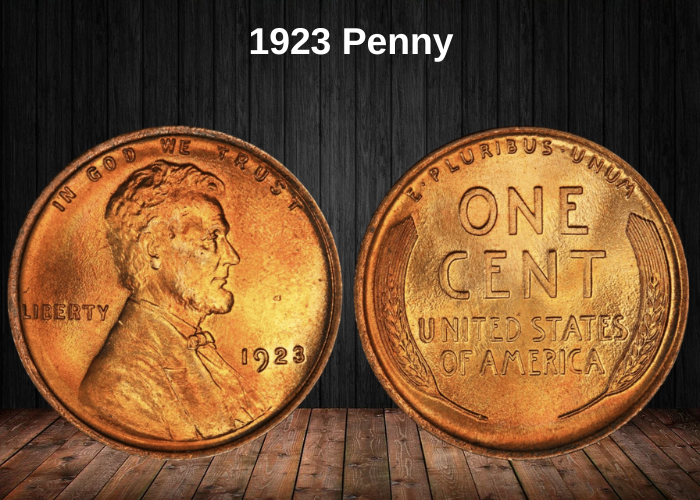
The History of the 1923 Penny
The 1923 Wheat Penny is a significant coin in the history of U.S. currency, part of the series that was produced from 1909 to 1958, featuring Abraham Lincoln on the obverse and wheat ears on the reverse. The 1923 penny, like its predecessors, is highly regarded by collectors due to its role in the broader context of U.S. numismatic history.
Context of the 1923 Penny
The year 1923 was a time of great social and economic change in the United States. The country was in the midst of the Roaring Twenties, a period characterized by economic prosperity, technological innovation, and cultural change. This was a time when the U.S. economy was booming, following the end of World War I, and new industries, including the automotive and radio industries, were rapidly expanding. At the same time, however, the U.S. was also experiencing the early stages of the social changes that would lead into the Great Depression in the 1930s.
The U.S. Mint was continuing its production of Lincoln Wheat Pennies, which were first introduced in 1909 to commemorate Abraham Lincoln’s centennial birthday. The penny was designed by Victor David Brenner, featuring the profile of President Lincoln on the obverse and two ears of wheat on the reverse, symbolizing the nation’s agricultural roots. The 1923 penny was part of this ongoing series.
Minting and Production of the 1923 Penny
The 1923 Wheat Penny was minted in three locations: Philadelphia, Denver, and San Francisco. The quantity minted and the distribution of the pennies during this time was vast, as the wheat penny series was one of the most commonly circulated coins in the U.S. during the early 20th century.
Unlike some other years, the 1923 penny does not have any significant errors or variations that distinguish it from the rest of the series, although it remains a popular coin among collectors due to its age. The 1923 Philadelphia penny is the most common, as it was the primary mint location during that year.
Here’s a breakdown of the minting figures for the 1923 Wheat Penny:
- 1923 (Philadelphia): 134,028,000
- 1923 D (Denver): 10,000,000
- 1923 S (San Francisco): 6,130,000
While the 1923 penny was produced in large quantities, the number of coins in good condition today is much lower due to the natural wear and tear they experienced in circulation. Thus, even though many were minted, the value of well-preserved 1923 pennies is significantly higher than those in poor condition.
Design of the 1923 Penny
- Obverse: The obverse of the 1923 penny features the famous portrait of Abraham Lincoln, the 16th President of the United States, designed by Victor David Brenner. This design was first introduced in 1909 and remained in use until the end of the wheat penny series in 1958. Above Lincoln’s image is the inscription “LIBERTY,” with “IN GOD WE TRUST” along the rim.
- Reverse: The reverse of the coin displays two stalks of wheat, representing the country’s agricultural roots, with “ONE CENT” in the center. This design was also used throughout the wheat penny series. Around the top of the coin is “UNITED STATES OF AMERICA”, and at the bottom, “E PLURIBUS UNUM” is inscribed.
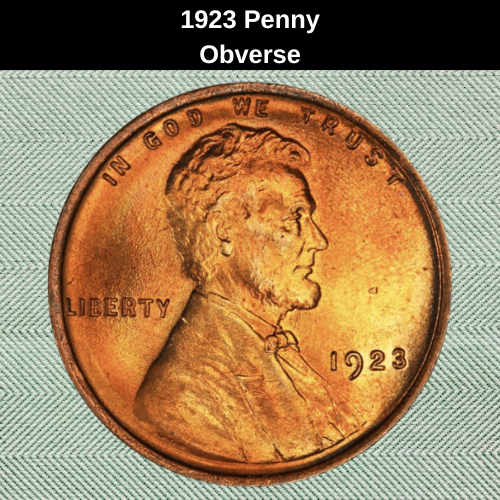
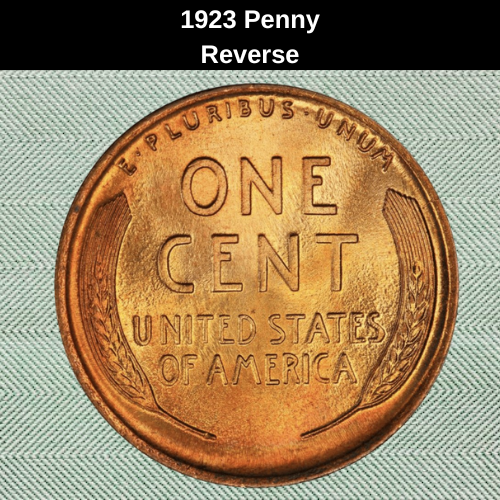
1923 Penny Grading
Most surviving 1923 pennies are well-worn. These circulated coins still sell for more than their one-cent face value, but they’re far from reaching the high prices of uncirculated coins, which are considered the creme de la creme of vintage coins.
Uncirculated coins are those with sharp strikes and shine and luster in the high points of the design. If your coin fits this description, you likely have a mint-state coin that could be worth hundreds or even thousands of dollars.
To become a coin-grading expert, you can check out this quick Lincoln penny grading guide, which not only covers the wheat pennies produced in 1923, but also some modern-day Lincoln pennies. Here’s a look at the grading scale for coins:
| Grade | Description |
|---|---|
| 1 | Basal State-1 |
| 2 | Fair |
| 3 | Very Fair |
| 4, 5, 6 | Good |
| 7, 8, 10 | Very Good |
| 12, 15 | Fine |
| 20, 30 | Very Fine |
| 40 | Extremely Fine |
| 50 | About Uncirculated |
| 60 | Mint State |
| 65 | Mint State |
| 70 | Mint State |
Be sure to check the grading guides to understand where your coin stands on this scale—it’s the necessary step to know the exact value of your coin.
1923 No Mint Mark Penny Value
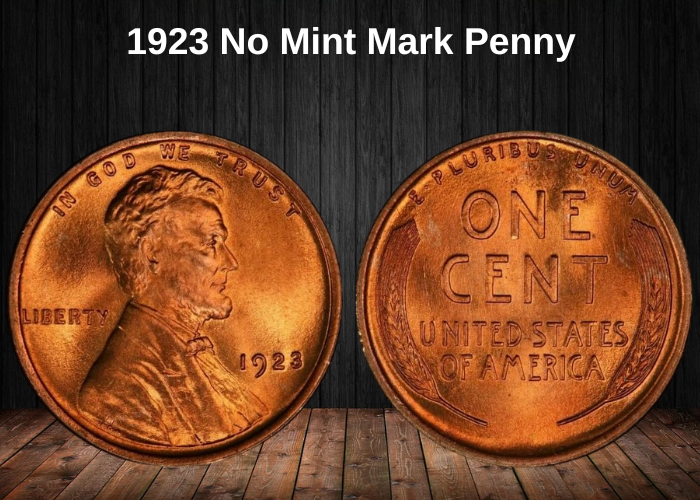
The Lincoln Wheat Penny was the first U.S. coin to feature the image of a real person. This broke the long-standing tradition set by George Washington, who opposed placing human figures on coins and paper money, believing it was something only monarchies did.
The release of this penny was perfectly timed—it was first issued in 1909, marking the 100th anniversary of Abraham Lincoln’s birth. The portrait on the coin was designed by Victor David Brenner, a Lithuanian-born sculptor who deeply admired Lincoln.
On the obverse of the coin, Lincoln is depicted in profile, facing right. Above his head, the phrase “In God We Trust” is inscribed in an arc. To the left, the word “Liberty” is visible, while the year of minting appears on the right.
The reverse side features the words “One Cent” in the center, with “United States of America” written just below. Two wheat ears frame the design on either side, while the top rim bears the phrase “E pluribus unum.”
The Philadelphia Mint has historically been the primary producer of Lincoln pennies, with Denver and San Francisco mints assisting in smaller but still significant quantities. However, in 1923, the Denver Mint was too busy producing gold and silver coins, so that year, only the Philadelphia and San Francisco mints struck pennies. The Philadelphia-minted coins had no mint mark, while the San Francisco ones were marked with an “S”.
Regarding the 1923 (P) pennies, over 74 million were minted in Philadelphia, with most being struck in the last quarter of the year as the country recovered from World War I.
Due to its high mintage, the 1923 (P) penny remains widely available today in various conditions, though many surviving examples show significant wear from circulation.
A 1923 (P) penny in good condition is valued at around $0.05. If in extremely fine condition, its price rises to about $10. About-uncirculated examples range from $11 to $18, depending on the grade (AU58).
For uncirculated coins, color plays a crucial role in determining value. Since these pennies were struck in 95% copper, their original red shine can fade over time, giving way to a brownish tone.
Collectors classify these coins into three categories based on color:
- MS Brown (least valuable)
- MS Red Brown (moderately valued)
- MS Red (most valuable and sought-after)
For example, a 1923 (P) penny in MS62 Brown is worth $32. If classified as MS Red Brown, it could sell for $45. However, an MS Red variety of the same grade could be worth as much as $60.
While 1923 (P) pennies are relatively common, finding an MS Red example in high mint-state condition is challenging. When found, their value increases significantly.
At a grade of MS65, an MS Red penny could be worth $350. Higher grades, such as MS66 and MS67, are even more valuable, reaching $1,150 and $5,000, respectively.
1923 S Penny Value
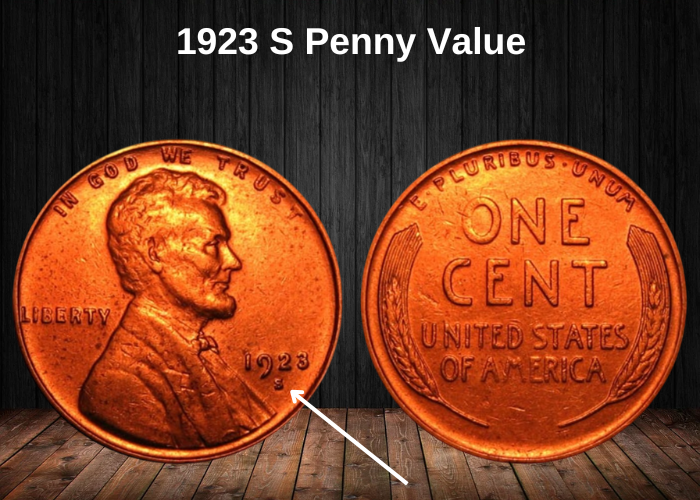
In 1923, the San Francisco Mint produced 8.7 million Lincoln pennies. Like those minted in Philadelphia, these coins were only struck toward the end of the year. You can identify them by the small “S” mint mark located just below the date on the obverse side.
Because of their low mintage, these pennies are rare and difficult to find. As a result, they have become highly sought-after and valuable among collectors.
Most 1923 S pennies were struck with worn dies, leading to coins with weak or incomplete details. Despite this, they remain valuable at all grades, even in circulated condition.
- In good, circulated condition, a 1923 S penny can sell for around $10—that’s 250 times its original face value!
- In extremely fine condition, its price rises to about $45.
- At AU58, the coin could fetch $240.
Finding a 1923 S penny with bold strikes and sharply defined details is a major challenge for collectors. Even rarer are those in mint-state condition with their original red luster intact. Because of this, MS Red examples in uncirculated condition are worth a fortune today.
For example, at MS64:
- An MS Brown 1923 S penny is worth around $850.
- If it has an MS Red Brown tone, its value jumps to $2,000.
- A fully MS Red version can command over $7,000.
However, MS Red pennies are the most valuable when they are in gem condition. A 1923 S penny graded MS65 Red is currently valued at an astonishing $60,000!
Only two coins have ever received an MS65 Red grade, making them exceptionally rare and highly prized.
Rare 1923 Penny Error List
More than 83 million Lincoln pennies were struck in 1923. With such a high mintage, it’s no surprise that some of these coins have mint errors. These errors can sometimes increase the value of a 1923 penny, making them highly desirable among collectors.
If you have a 1923 penny, be sure to inspect it carefully—you might have a rare error coin worth significantly more than its regular counterpart!
1923 Penny Obverse Struck Through Thread Error
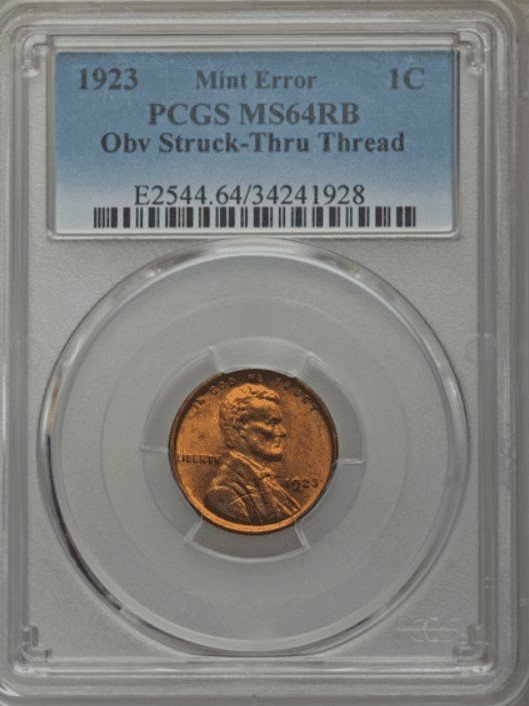
One interesting error found on a 1923 penny is a struck-through error on the obverse. A struck-through error happens when a foreign object is accidentally placed on top of the planchet just before the die strikes it. This object then leaves a distinct impression on the coin.
An example of this error was discovered on a MS64 Red Brown coin. On Lincoln’s chest and shoulder, there was a prominent, recessed line running through the planchet. It appears that this line was caused by a piece of thread that became stuck on the planchet before it was struck.
This error coin eventually sold for over $150, highlighting how such mistakes can significantly increase the value of a coin.
1923 Penny Struck 15% Off-Center Error
Another fascinating error found on a 1923 penny is the off-center strike, which is one of the most well-known mint errors in coinage.
This error occurs when the coin is struck slightly askew, meaning the die doesn’t align properly, causing part of the design to be missing and leaving a portion of the planchet blank. A coin with a fully centered design cannot be considered an off-center strike.
For example, a 1923 MS61 Brown penny was once discovered with a strike that was about 15% off-center. On this coin, the words “WE TRUST” were completely missing because of the misalignment. The error created a crescent-shaped blank area on the coin, located around the seven o’clock position.
This off-center error eventually sold for nearly $500, showing how such mistakes can make a 1923 penny significantly more valuable.
1923 Penny Uncentered Broad Strike Error
A broad-struck coin is often mistaken for a coin struck off-center, but they are distinct errors.
Both errors occur due to the incorrect placement of the coin during the striking process, leading to an uncentered strike. However, the key difference is that a broad-struck coin retains the full design across the coin’s surface, unlike an off-center strike, where part of the design is missing from the edges.
An example of a broad-struck error was found on a 1923 (P) XF45 penny. This penny was sold for around $50 due to the error. If it had been in a higher grade, such as a mint-state coin, it would likely have fetched a much higher price.
1923 Penny Partial Collar Strike Error
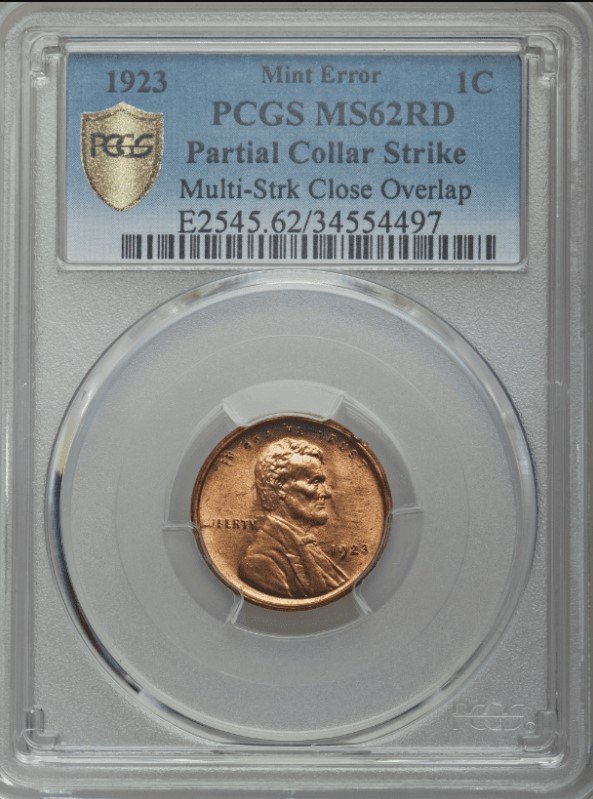
A partial collar strike error occurs when the planchet is misaligned and sits askew inside the die collar before it is stamped. As a result, when the die strikes the planchet, some of the metal is pushed into the collar, causing the planchet to extend beyond the normal boundaries of the coin.
This error gives the coin a wide and “stepped on” appearance, with the most noticeable distortion around the edges of the coin.
An example of a 1923 MS62 penny with a partial collar strike error was once found and sold for over $310, highlighting the significant value such an error can add to a coin.
Where to sell your penny?
Now that you know the value of your penny, you might be wondering where to sell it. Don’t worry: here’s a guide to some of the best online platforms where you can easily sell your coins, along with their advantages and disadvantages.
Discover the best platforms for selling coins online (pros and cons).
1923 Penny FAQs
Q1: What factors contributed to the high mintage of the 1923 Wheat Penny in comparison to other years?
The high mintage of the 1923 Wheat Penny, especially from the Philadelphia Mint (134 million coins), can be attributed to several factors:
- Economic Prosperity: The early 1920s were marked by strong economic growth, following the end of World War I. This period, known as the Roaring Twenties, saw a surge in consumer demand for currency.
- Increased Industrial Production: As the U.S. economy expanded, so did the demand for coinage. The production of everyday currency like pennies was necessary to support the growing workforce and consumer economy.
- Stable Coin Design: By 1923, the design of the Lincoln Wheat Penny had been in circulation for over a decade, and it was well-established as the main penny design. No significant changes to the coin were made in this period, meaning the U.S. Mint could focus on producing large quantities rather than designing a new coin.
Q2: Why is the 1923 S (San Francisco) variety more sought after than the 1923 D and 1923 Philadelphia?
The 1923 S Wheat Penny is more sought after than its counterparts due to its relatively lower mintage (6,130,000 coins). Although not as rare as some other varieties in the Wheat Penny series, its limited production makes it more desirable among collectors. Several key points contribute to its desirability:
- Lower Mintage: The San Francisco Mint produced far fewer 1923 pennies compared to the Philadelphia Mint. This makes it a scarcer variety.
- Geographic Distribution: The 1923 S penny may have circulated more regionally in California or other parts of the western United States, making it less likely to be found in other areas.
- Collector Demand: Rare coins from San Francisco often hold higher value due to the mint’s historical significance and the relative scarcity of its coinage.
Q3: What makes the 1923 Wheat Penny one of the last great examples of the “classic” penny design before major changes?
The 1923 Wheat Penny is significant because it is one of the last coins minted before the major redesigns that would take place in the following decades. Key points about this transition include:
- Design Stability: The Lincoln Wheat Penny design, created by Victor David Brenner, remained unchanged from 1909 until 1958. The 1923 penny, therefore, represents the last years of this classic design before it was replaced by the Lincoln Memorial Penny in 1959.
- Symbolic Design: The Wheat Penny’s design, with Lincoln’s portrait and wheat stalks, symbolized both America’s leadership and agricultural roots. The design was also a nod to the agricultural sector, which was crucial in the early 20th century.
- Historical Context: The 1923 Wheat Penny was minted during the Roaring Twenties, a period of economic growth and social change. It encapsulates a moment in American history before the coinage system underwent significant transformation in the coming decades.
Q4: Why is the 1923 Wheat Penny not known for significant minting errors, and how does this affect its collector value?
Unlike other years in the Wheat Penny series, the 1923 Wheat Penny is not particularly known for significant minting errors or varieties. This lack of error coins influences the collector value in the following ways:
- Predictable Production: The 1923 coinage was largely free from the errors that might have increased the value of other years, like the 1922 “No D” error. While there are a few subtle variations based on mint marks (like the 1923 D or 1923 S), the absence of major minting flaws or anomalies means the coin’s value is largely driven by its condition, mint location, and rarity.
- Stable Demand: Since there were no major errors or varieties in 1923, the demand for these coins remains stable, with less speculation compared to other rarer coins in the series.
- Value in Condition, Not Variety: The value of the 1923 Wheat Penny largely depends on its condition rather than its rarity or unique characteristics. As a result, high-quality uncirculated examples will fetch higher prices, but the lack of errors means there aren’t “extremely rare” varieties in this year.
Q5: How did the Great Depression affect the long-term value and perception of the 1923 Wheat Penny?
The Great Depression (1929–1939) had a significant impact on the U.S. economy and the public’s perception of currency, including coins like the 1923 Wheat Penny:
- Depression-Era Impact on Coin Circulation: The onset of the Great Depression led to widespread financial hardship, which caused coins like the 1923 penny to be used for practical purposes and circulated heavily. As a result, many 1923 pennies were worn down, making higher-grade examples scarcer.
- Coin Hoarding: As the economic situation worsened, some collectors and investors began hoarding coins, including older pennies like the 1923 Wheat Penny. This shift in behavior increased interest in coins as a form of financial security and a store of value.
- Perception of Value: During the Depression, U.S. coins became more symbolic of the nation’s struggles and its eventual recovery. The 1923 Wheat Penny, as a part of the early 20th-century coinage, gained cultural and historical significance, elevating its appeal in the numismatic market after the economy stabilized.
Q6: How does the 1923 Wheat Penny reflect the changing American economy and society during the 1920s?
The 1923 Wheat Penny serves as a window into the economic and social transformations of the United States during the 1920s. Here’s how it reflects that period:
- Agricultural Symbolism: The reverse design featuring two stalks of wheat is symbolic of the American agricultural economy, which was still very important in the early 20th century. However, the 1920s also saw the rise of industrialization, making the coin a bridge between agricultural tradition and the growing industrial economy.
- Cultural Evolution: The Roaring Twenties was a period of significant social change. This was a time of greater consumerism, technological advancement, and cultural upheaval, symbolized by figures like Abraham Lincoln, a leader who guided the nation during its greatest internal conflict (the Civil War). The coin became a reminder of the nation’s history while witnessing the dawn of modernity.
- Economic Prosperity: The large mintage of the 1923 penny correlates with the period of economic prosperity and optimism. The booming stock market, the growth of consumer goods industries, and the rising availability of cars and radios all signaled an era of confidence and progress in America.
Q7: How does the 1923 Wheat Penny compare to other pennies in the Wheat Penny series in terms of market demand and collector interest?
While the 1923 Wheat Penny is not as rare as some other years (like the 1909-S VDB or the 1922 No D), it still enjoys considerable interest from collectors for a few reasons:
- Middle Ground in Rarity: The 1923 penny isn’t as rare as the 1922 No D or the 1914-D, but it holds an important place in the middle of the Wheat Penny series. This middle-ground rarity makes it a desirable yet accessible coin for collectors at various levels.
- Historical Value: Collectors interested in coins that encapsulate an important time period in U.S. history (such as the Roaring Twenties) often seek out the 1923 penny as part of a broader collection.
- Minting Variety: The 1923 D and 1923 S coins are valued more than the Philadelphia version due to their lower mintages, attracting collectors who specialize in rarer varieties. However, the overall market demand for the 1923 penny is more moderate compared to years with significant errors or rarities.


















































